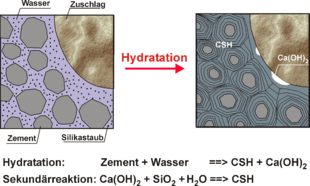High strength concrete
In the standards, concretes with a cylinder compressive strength of greater than 50 N / mm² up to and including 100 N / mm² (C 100/115) are classified as high-strength concrete . The first high-strength concrete standardized in Eurocode 2 is a C55 / 67, which must achieve a characteristic cylinder compressive strength of at least 55 N / mm².
Water-cement ratio
The high-strength concretes are characterized by a dense and homogeneous structure with a low proportion of capillary pores. In terms of the concrete formulation, they differ from normal concrete primarily in that they have a lower water-cement ratio . In normal-strength concretes, the addition of water is usually 0.5 to 0.7 times the cement mass. This ratio is reduced to values between 0.35 and 0.25 for high-strength concrete. High-strength concrete therefore contains less water than is necessary for complete hydration of the cement (w / z ~ 0.40). In addition, there is very little unbound water in the cement stone, which causes the formation of capillary pores. In addition, unhydrated cement clinker is available as a high-strength "aggregate", which has an optimal bond with the surrounding hydrated cement stone.
Superplasticizer
In terms of workability suitable for the construction site, low water-cement values are only possible through the use of high-performance superplasticizers . The action of the superplasticizers is based on a distribution of the cement agglomerates and a kind of lubricating effect. Since the addition of microsilica stiffens the fresh concrete and creates a “sticky” consistency, the flowable consistency range (KF) or slump class F4 with a slump of more than 49 cm should be aimed for.
Silica
In addition to the low w / c ratio, the higher concrete strengths are primarily achieved by adding the finest additives. For this reason, silica fume is usually added in the production of high-strength concretes . The silica particles are around 30 to 100 times smaller than the cement grains and consist almost entirely of amorphous silicon dioxide , which is produced during the production of silicon metals and ferrosilicon and is extracted from the flue gases by means of electrostatic filters. The strength-increasing effect of the micro-dust can be explained by three causes:
- Due to their shape and size, the silica particles are able to fill part of the pore space between the cement grains. This significantly increases the structural compaction of the cement paste caused by the dispersing effect of the superplasticizers and a higher density is achieved (micro-filler effect).
- In addition to cement hydration, a pozzolanic secondary reaction takes place between the calcium hydroxide produced during cement hydration and the silica fume . Calcium silicate hydrate is formed, which has a higher strength than the starting materials.
- Another important reason is the significant improvement in the microstructure in the bond zone between cement stone and aggregate. The reason is a reduction in the calcium and ettringite content in the contact zone. This can also be seen from the fracture surfaces of high-strength concrete test specimens. The surfaces are relatively smooth, the break does not occur around the aggregates as with normal strength concrete , but through the aggregates.
The improved bond between aggregate and matrix mainly contributes to the increase in strength, the pozzolanic secondary reaction only by about 20 percent.
Cements with a high grinding fineness
In high-strength concretes, cements are also used which are ground much finer than the usual 3200 to 3500 Blaine of Portland cement Pz35 and can have values of 5000 to 5500 Blaine. These fine cements are extremely expensive to manufacture due to their large specific surface area; they consume considerably more energy for their grinding and cannot be produced with any kind of cement mill. They also place special demands on the separation process (separation) and the machines used for this ( classifier ). In addition, increased requirements are placed on the storage in order to be able to maintain the high specific surface over the storage period.
history
As early as the early 1950s, Otto Graf managed to produce concrete with a compressive strength of 75 N / mm². With a w / z-value of 0.32, basalt aggregates and were hardened at low temperatures and under pressure the mid-1960s by Kurt rolling in the laboratory strengths of up to 140 N / mm² achieved. The breakthrough for the production of high-strength in-situ concrete came with the discovery of silica as a concrete additive and the development of high-performance liquefiers in the 1970s. It was first used in Germany in 1990 with a B 85 at the Trianon high-rise in Frankfurt. Further experience was available in 2008 with regard to the use of high-strength concrete in bridge structures and floor slabs in accordance with the Water Resources Act .
Web links
- High-strength concrete / high-performance concrete. (PDF; 116 kB) cement data sheet concrete technology B16 10.2002. Construction advice cement, accessed on January 21, 2017 .




